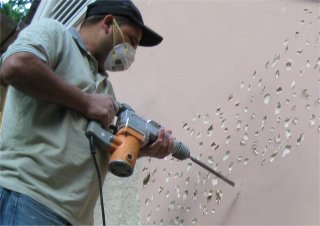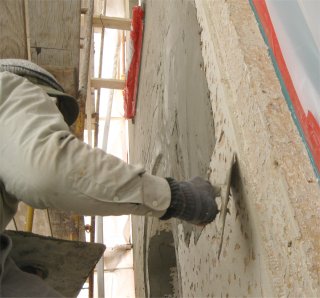Recoating old stucco, painted and unpainted
I got smooth finish stucco added on my textured stucco house 2 yrs ago. It has started to turn white in areas and crumble off the block wall first and now parts of the house. Anyway to stop this without spending another $10,000 ?
I want to put a new finish coat over an existing hardcoat portland cement stucco house that has never been painted. Is this as easy as cleaning the existing walls and putting on a new finish coat ?
Painted stucco: I just found your website. Thanks for all of the useful information. We have a house built in 1970. It has the coarse type of stucco on it (that looks like very, very coarse sand paper). It has several layers of paint over the top of it. The stucco is in fairly good condition except for some small cracks in a few places (California earthquake area). We would like to have someone refinish the stucco by adding a smooth top coat to the existing stucco with a color added. Is it possible to just smooth on a topcoat over the existing stucco and paint? Or do we need to have all of the paint and/or stucco removed prior ?

First. wall is chipped into the old stucco about every 3-4" or so, enough to give the new mortar a good bond on the old stucco basecoat.

A thin bonding coat is applied. This is our normal mixture of cement and sand, mixed with a solution of half water and half bonding admixture. This mixture is real sticky and provides good adhesion to both the old paint and old basecoat. The surface is left rough for a good bond of the cement finish coat.
Unpainted stucco:
One problem is old bricks that are soft and porous. Mortar doesn't bond very good because there is too much suction. The mortar absorbs water too fast and will absorb the water out of the mortar instead of absorbing mortar into the brick. We use a bonding admixture in the mortar in this case.
Another problem is bricks that are slick. We usually chip up the bricks to make them rough and use a bonding admixture.
It is possible to nail metal lath to a brick wall by using long nails and angling the nails into the joints. This is what they did putting on Formstone years ago. Nowadays, people take off the Formstone and they can fill in the brick joints. When people nailed lath to the brick, usually the brick was broken up, and couldn't be restored.
I have found chemical bonders are better than using metal lath on brick, particularly painted brick.
If the mortar joints have badly deteriorated or the mortar has washed out, All we do is force enough mortar in the brick joints to hold the bricks together when we put on our scratch coat, so there is no need for tuckpointing.
If there is any paint or tar, it should be chipped off.
Here is an example of old soft bricks that were deteriorated in spots:
http://www.rtbullard.com/stucco/progress/gooch02.htm.
Here is a job we did recently:
http://www.rtbullard.com/stucco/progress/progress110.htm.
The bricks here were a little slick on the surface, so we used acrylic in the scratch coat. On newer bricks that are rough on the surface, you can put the mortar without acrylic directly on the bricks and have a very permanent bond, The bricks should be wet first, preferably soaked with a hose. You also may expect a lot of shrinkage cracks in the scratch coat that will look like a road map of a mountainous region. This is normal, and the cracks will fill in with the brown coat . You may reduce the cracking in the scratch coat by adding additional sand to the mix, but this will be the subject of a future article.
We stucco over painted brick and stucco a lot with excellent results. Acrylic admixtures have created a new industry for us. Here are other examples of jobs we have done this way:
http://www.rtbullard.com/stucco/progress/lewis.htm.